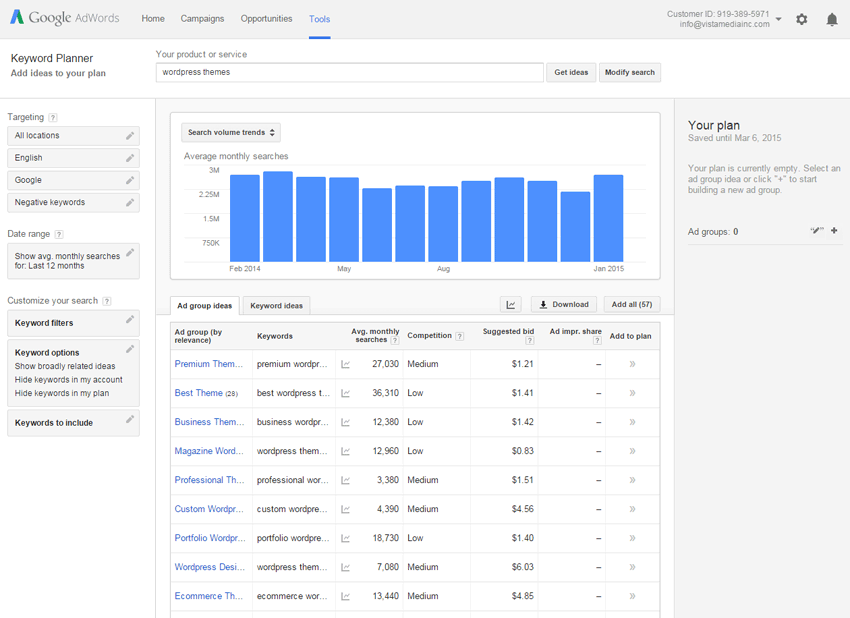How Do I Get Traffic To My Wordpress Blog
How to Drive More Traffic to Your WordPress Site
Last updated on:
Let me know if this sounds vaguely familiar. You started off with a desire – a shred of an idea that kept you awake at night. After wracking your brains, you decided to pour the idea into a plan, perhaps after reading motivational text such asThink and Grow Richby Napoleon Hill.
With the plan in hand, you went ahead and made an effort of transmuting the dream into reality. You went to work, purchased web hosting, a domain name, a great WordPress theme and set up your first WordPress site.
You were going to make it, you could feel it in your gut. Your eyes were green; you could make a killing eventually, and live your dreams. But the plan was somewhat flawed, since it didn't account for traffic generation, the only lion barring your road to success today.
You nearly panicked when you discovered your folly, but still, you kept at it, researching and arming yourself with new information on traffic generation. Still, the numbers just weren't there. You kept wondering what in the name of Santa happened to "build it and they will come." What could you have done wrong?
You started doubting whether you could turn your young blog into a successful website without the quintessential ingredient that is web traffic. You quickly figure out this is impossible, and drop that line of thought.
Yet you're not a quitter, so you could not imagine putting the tools down and closing shop. Perhaps you had no other option, so closing down wasn't really an option after all. Well, don't worry at all if this doesn't sound like you, because much of it is my very own story.
Perhaps you're just here because you would like to learn a few things on how to drive more traffic to your WordPress site. Perhaps you're here because the few hits you're getting won't just cut it. You want more, and you want it now. Perhaps – just like yours truly – you started with a flawed plan, and a few months down the line – you found yourself here. Maybe, you haven't even started. You can learn how to start a blog in minutes.
Whatever reason you are here, today is your lucky day as you will learn almost everything you need to drive more traffic to your WordPress-based site/blog. Towards the end of this post, we will share a few tools you can use to generate more traffic for your website, so be on the lookout for that as well.
Enjoy to the very end and don't forget to share your thoughts with us in the comments! We always appreciate your input 🙂 Without wasting another second on trivialities, let's get this over and done with.
Search Engine Optimization

SEO is how I broke into the world of digital marketing. Long before I discovered WordPress, I was an SEO writer. Which means I had to learn a lot about the art of enticing search engines to find content.
All the learning paid off later when I went into business for myself. Using the SEO techniques I had learned, I crafted content that ranked highly in Google, in turn earning meself a great deal of traffic to my WordPress blog.
And for a long time, Google has remained my number uno source of traffic, even after I discovered guest blogging, and reduced the frequency of posting on my own blog. This led to my concluding that SEO is the best way of attracting web traffic. It's easy work albeit it takes time, and anybody with a little knowledge and some passion can hack it.
How?
First off, for the sake of absolute beginners, it's paramount to mention that SEO involves optimizing your content (as well as your entire site) to make it easily discoverable in search engines such as Google. That's all there is to it.
The objective is to appear in the first ten (10) positions in search engine result pages (SERPs). Best, of course, is to come first.
Secondly, SEO is broken into two categories namely on-page and off-page SEO. The former involves every SEO activity you perform on your own site and the latter involves SEO activities that involve third party websites, hence the termson-pageandoff-pagerespectively.
To drive more traffic to your WordPress site, you need to approach SEO in its entirety. You should engage in both on-page and off-page SEO. But, what do you need to do technically speaking?
Keyword Research

Astute keyword research is the foundation of great SEO. When users have a pressing problem (call it a need), they will rush to their favorite search engine with the hope of obtaining a solution.
They enter words or phrases into the search engines, hit enter and if your content is optimized with these terms, you're given preference. What I mean is if you've done your work really well, Google and other search engines will display your content first, earning you traffic.
If you look at it critically, you immediately realize that you must know the keywords or key phrases that people are using to find your business as well as products. This is where keyword research comes in.
Once you determine these keywords/phrases, you can add them to your content in order to improve your chances of appearing first in search engines. If you play your cards right (which just means following these SEO Guidelines), you will always score top positions in SERPs, and earn yourself more traffic.
If you keep at it – publishing SEO-ready blog content consistently and implementing the other recommended SEO techniques – you will continue enjoying top rankings and more traffic for days, months and years to come. For instance, I still rank well for the phrase "latest SEO techniques and trends" thanks to a post I published two years ago. What a shameless plug. Haha.
But how do you tackle this animal called keyword research? Where do you begin? You can begin your journey with a tool such as the Google AdWords Keyword Planner. With a primary keyword in mind, you can bank on Google AdWords Keyword Planner to determine the search volume and generate more keyword ideas.
Blog ideas can come to you as well as you carry out your keyword research, so the rewards are many. Other tools include Google Webmaster Tools, Bing Keyword Tool, WordTracker and SEMRush among others.
Armed with your keywords, you're primed to create awesome content that will show up in search engines. The ideal keyword density to aim for is 2.5%, meaning if your blog post is 1000 words long, your keyword should appear about 25 times naturally. Don't go beyond 4.0%, because Google will think you're just spamming.
Additionally, make sure you add your keyword to your page title, preferably at the beginning. Keywords in your subheadings count as well, so don't forget that as well. Add your keywords to your URLs as well so search engines can pick them up easily. That's not the end of it. Throw a few keywords to your image file names, and include the ALT attribute, and if possible, place your keyword in the ALT as well.
Every post or page you publish should have headings, tags and meta descriptions because search engines use this information to rank your content. Even if you've never created a WordPress post before, adding headings (h1, h2,h3…h6) shouldn't be a challenge – they are all in the visual editor.
Adding meta titles and descriptions (called meta data collectively) on the other hand isn't exactly easy. But worry not, you can easily optimize your WordPress post and pages using WordPress SEO plugins such as WordPress SEO by Yoast and All in One SEO Pack.
Ensure your website is visible to search engines by navigating toSettings -> Readingin your WordPress admin area, and deselecting "Discourage search engines from indexing this site".Otherwise, all your SEO efforts will be in vain.
I will leave it at that because we've already covered this and other SEO techniques in detail in our recent post: WordPress SEO Best Practices for 2015 and Beyond. Please check out that post if you wish to drive more traffic to your WordPress site using SEO. Moving on…
Your Interlinking Strategy

See how I just linked to our other post in the section above? That there is what we call interlinking. But how does this boost your traffic? It's simple mechanics. By linking to your other posts, you give your readers the opportunity to find more of your content.
If they just read your entry post (such as this one) and left, you would register a higher bounce rate, and you would lose SEO points, and hence web traffic. You would be right to argue that search engines love natural internal linking.
At the same time, by linking to your other posts, you improve the chances of getting more of your content discovered, read and shared. When users share your content, you attract more traffic and if this keeps repeating, your traffic will only keep growing.
You can link to your other posts within your content (like we just did a few moments ago) or take advantage of related post plugins such as Zemanta or any of these related posts plugins. These plugins create a "related posts" section at the end of your post (or in the sidebar) boosting engagement, page views and ultimately, traffic.
Email Marketing

Neil Patel, he of QuickSprout revealed that one of his greatest source of traffic is the email list. And once we go into the details, you will understand why.
First off, he has a huge email list that he has built over the years. Secondly, he doesn't seem to have a problem collecting emails because, one, he is a thought leader, and two, he has the tools in place that makes emailharvesting (for lack of a better word) a breeze. Thirdly, he shares great content in his email newsletters, and I know that as I'm one of his subscribers.
It doesn't take much to click on the links in the emails and end up on QuickSprout, where thanks to interlinking, you end up going deeper into the site, and even signing up on Crazy Egg, one of his other companies. Yet, he makes all of it appear effortless, and the results? More traffic to all of his websites, not just QuickSprout. Much of it is repeat traffic, and you know what they say; repeat traffic is where the real money is.
If you would like to drive more traffic to your WordPress site, you want to borrow a leaf from Neil Patel's book. Emulate his style, and you should be able to hack email marketing like the pros. This means you should endeavor to build a great blog first.
Then you should encourage peeps to sign up to your newsletter. Offer them free guides, eBooks, free memberships – whatever it takes to populate your email list. Don't stop there, feed them great content via email consistently and don't neglect your blog. With time, your email list will be a great source of traffic, referrals and the moolah.
Email marketing becomes easier and much more fun when you have the right tools and partners by your side. And WordPress being the gracious platform it is, there are a couple of plugins available to power your email marketing efforts. A couple good examples include the free MailPoet plugin, or the premium MyMail plugin.
Third party email marketing services include AWeber, MailChimp, Constant Contact and Mad Mimi among others. All of these services integrate well with WordPress allowing you to concentrate on what matters – developing awesome content and making money.
If email marketing doesn't sound like your cup of tea, at least enable subscriptions via feed and email. You don't have to sweat the process. After all, there are couple great WordPress feed plugins to help with this.
Leverage Social Media

The internet is home to a huge number of social networking sites and more are born every other day. These social networking sites attract huge volumes of traffic, traffic that you can have a piece of. It's there ready for the taking, and all you have to do is dip your fingers in the cookie jar no pun intended.
How? You can start by creating both personal and brand accounts on a few of the social networks including but not limited to Facebook, Twitter, Google+, LinkedIn, Reddit and StumbleUpon.
Your goal would be to share all your posts and pages on these platforms. If you can find a few people who are willing to champion your cause on these sites, then you've won half the battle. If you need pushing, Wikipedia curates a decent list of social networking sites here.
As you take the battle to social media sites, your efforts should be guided by one general rule. Endeavor to provide real value at all times as opposed to, say, spamming the hell out of people. Nobody likes that guy, or as Rand Fishkin puts it:
Simply drive-by spamming or leaving your link won't get you very far, and could even cause a backlash. Instead, learn the ropes, engage authentically and you'll find that fans, links and traffic can develop.
That aside, WordPress comes bundled with the awesome Jetpack plugin that comes with a publicize module. Once activated, Publicize will automatically share your posts with your readers on social media.
While this is a good thing, activating all the features of Jetpack has been known to decrease your page speed significantly, which leads to a higher bounce rate, poorer user experience (UX) and ultimately less traffic. Exercise caution and only activate the features you need.
However, publicizing and sharing your posts on social networking sites isn't enough. You need to go a step further and make it incredibly easy for readers to share your content. Have you ever been to a WordPress blog with so much great content and zero social sharing buttons that you had to copy the link to share with your followers?
I have, and it's frustrating – having to copy and paste the link, while the blogger in question could have just installed a social media plugin. There are so many of them, social sharing plugins, both free and premium that no WordPress publisher should run a website without sharing buttons.
WordPress comes with its own social sharing buttons in the name of Jetpack sharing, so you have no excuses whatsoever. All the same, if you would like to take your social media sharing game to the next level, feel free to check out the awesome collection below:
- 25+ Best Social Media Plugins for WordPress
- Social Media WordPress Plugins to Increase Traffic
If you write great content, and one of your brand ambassador picks it up on social media, and then another and another, your post will go viral, and bring back a lot of traffic. Such is the power of social media. Do your part; create awesome content and make it easy to share.
Improve the Speed of Your Site

Driving more traffic to your website will mean nothing if you can't retain the visitors you get. If the visitors have a terrible experience on your site because it's a snail, they will never come back, which just means your numbers will drop, even if you attract many new visitors.
As a web master, you need to concern yourself with two metrics – new visits and returning visits. If a huge chunk of your traffic keeps coming back to your site, then you're doing something right.
If you're getting many new visits but your bounce rate is way high, you need to rethink your entire strategy – because what's the use of having a million visitors who never click your CTAs. I mean, what's the point of attracting the entire world, if they never bother coming back when they leave?
Improving the speed of your site has a strong correlation with UX. If your site loads very fast, visitors will appreciate your efforts, and since buying is all about emotion, you will have one foot inside the door. You won't lose the traffic, and more people will be willing to stick around long enough to swallow your bait
You can check how your WordPress website performs in the speed department using tools such as GTMetrix, Pingdom Tools and Google PageSpeed Insights among others. Any of the linked tools will give you a speed score and suggestions on how to improve the speed of your site.
If your website is sluggish (takes more than 5 seconds to load), please take a moment and checkout How to Decrease WordPress Page Load Time. Google will also reward you with better ranking for a faster website, so yeah, it's a win-win for you!
Write Great Blog Content Regularly

Writing great blog content regularly will endear you to search engines as well as human readers. By any means, what makes a post "great" aka engaging or moving is a matter of opinion.
What's not a matter of opinion is bad grammar, spelling errors and other careless mistakes that you can take care of with some slight editing. To create great content, you must ensure it's at least readable and free of errors – for clarity sake. Poorly written content that's riddled with errors will only send your readers and traffic away.
On writing regularly, a blog that publishes fresh content regularly appeals to search engines in a great way, meaning more readers will find your website. At the same time, the consistency you manifest by posting regularly creates loyalty among your readers, which has a huge impact on your web traffic.
So proofread your posts before publishing and follow your editorial calendar. Don't have an editorial calendar? This editorial calendar plugin will help you 🙂
Pay for Traffic
If you paid for web traffic and got what you bargained for, you wouldn't be here reading this post, now would you? But I figured I should mention that you can drivemoretraffic by complimenting yourfreetraffic generation strategy with some paid traffic.
I won't waste your time on this; there are several avenues open to you:
- PPC– Short for Pay Per Click advertising , which involves paying a company such as Google some predetermined amount of money whenever a visitor clicks on your ad. You pay for every single click, and the dollars can quickly rack up. Suffice to say, you need a sizeable budget to realize tangible results.
- Social Media Ads– You can choose to advertise your business on social media sites such as Facebook and Twitter among others. This is a great way of broadening social media presence. For about $50 bucks, Facebook will give you about 1,200 – 1,500 likes. Twitter offers a similar deal, but I have no idea how many followers $50 gets you. Do you have a clue? Please share with us in the comments. You can also advertise your WordPress website directly on social media as opposed to just acquiring likes or followers.
- Advertise on Other Websites – Where is the best place to get a huge volume of targeted web traffic? 10,000Temple Runcoins to you if your answer is "other websites in your niche." Come on, it'sTemple Run,the coins must be worth something. Jokes aside, the best place to get targeted web traffic is other popular websites in your niche. So if you can strike up rapport with publishers in your niche and have them run your ads for a small fee, you will get plenty of visitors who might be interested in your offer.
But what if you don't have the spread to spend on adverts? How else can you make an appearance on other websites and get your brand and name out there?
Guest Blogging

Two years ago, I wrote my first guest blog, and guess what, the post was about guest blogging. I, for lack of a better title, conveniently titled the post: Guest Blogging Tips: Are You A Guest Blogger or a Guest Blojjer? It didn't get as much traction as I had expected but hey, I was still learning the ropes.
But ever since, I have been guest blogging on a number of platforms, and save for Google, this technique has brought me a great deal of traffic, and opened many doors for yours truly.
Guest blogging has earned me clients, won me great friends and has improved my brand image tenfold. If I had concentrated 100% on my website, I would never have made the strides I'm so proud of today. But enough about me.
Guest blogging can help you in a number of ways:
- It will help you drive more traffic to your site
- It establishes you as an expert
- If you guest blog in your niche, it puts you in front of a wider audience
- If you get paid to guest blog, you can make a living
- You create professional relationships
- You learn so much
- You receive great deals e.g. free hosting, free memberships, gifts and whatnot
- You get the chance to proof yourself and be awesome
- Et cetera, et cetera
Only guest blog to provide real value, not to earn the backlink. As many experts have said before, when it comes to guest blogging, the backlink is simply a reward for all the work that goes into making the post.
When done right, guest blogging will earn you traffic for years to come. Guaranteed.
Networking
The internet has made networking a whole lot easier. You can rely on, say, Google Hangouts to network with publishers on the other side of the globe. At the same time, this has eliminated the human element, making networking faster but lacking in intimacy, the stuff that defines strong business relationships.
As far as driving traffic to your WordPress site, human-to-human (or face-to-face) interaction helps a great deal. Attend events and meet your readers in person in that next WordCamp. You can go a step further and even organize events, and sure enough, you can expect a surge in traffic.
If there's some media coverage, you can expect more hits – just make sure to mention your website somewhere in there.
Track Your Traffic As Is
![]()
Unless your website doesn't exist, you're bound to attract readers even if all you have is ten blog posts. I'm in no way encouraging slacking as far as creating content is concerned, but every website with some decent content will pull some traffic.
Considering you probably have a ton of posts (or are planning to publish a ton), you must pull in some traffic. If you do your due diligence and study the traffic you're pulling, you can identify areas that need reinforcing and areas that need sending to the back burner.
Perhaps a particular type of post performs better than all the rest. Perhaps, your traffic comes from a certain country and you're targeting a different location entirely. Perhaps you're not using the right keywords. Perhaps this, perhaps that; you get the point.
You can only drive more traffic by playing to your strengths and/or eliminating your weaknesses, not forcing your way. Study your traffic and make the necessary amendments. If you don't know where to start, your WordPress stats screen is an ideal start point. You can also use tools such as Google Analytics. Then make changes as needed.
Great Blog Design
You can spot an unattractive website from a mile away. A design that's a pain to the eye will send your prospects away, because, well, who likes ugly? If no one wants to stick around because your website design sucks, tell me my friend, how are you going to generate more traffic?
Create a beautiful, unique and professional design that catches attention, and you won't have to struggle catching traffic. It's simple as that, and everything ties back to that UX point we mentioned earlier.
Ensure your ads are in order and you're using responsive design to make your website ready for mobile device users. In case you didn't know, mobile traffic will surpass desktop traffic in 2015 going forward.
Link and Comment on Other Blogs

When you think of linking to and commenting on other WordPress blogs, think of the saying "no man is an island." It's the inter-net – the whole thing is built around the concept and philosophy of linking resources to form a web that benefits us all.
By playing lone wolf, you deny yourself the chance to discover unchartered territories and grow. When peeps comment on your blog, doesn't it feel incredibly good? Don't you wish just one more person would find your blog post and leave a great comment?
Well, if you want more people to find your blog and leave comments, you have to show up on their blogs and leave a comment as well. This might not earn you a great deal of traffic but it's good karma and you get the chance to meet other people who are interested in the same things as you. Try your best to add real value to the conversation – don't spam.
When creating blog content, link to relevant resources on third party blogs, and since it's good karma, you will eventually get links back to your blog, especially if you create awesome content. That there is more traffic for you buddy.
Either way, you end up creating inbound and outbound links, which is great for SEO, and ultimately traffic generation. It's a win, win, win!
Organize Competitions
Competitions and giveaways are a great way of driving more traffic to your blog. If you have a special deal on WordPress themes to give away, you can have people enter the competition either by liking the giveaway on Facebook or tweeting it to friends. You can even ask the readers to subscribe and share the competition in whichever way you fancy.
The further out the word spreads, the more traffic you get back to your blog. You've seen how we run some great giveaways on this blog. Go ahead and replicate the same on your blog and you will enjoy more traffic and better user engagement. Need I say more?
Bonus
This post can go on for an eternity, so allow me to list the remaining points (they're all self explanatory):
- Use breadcrumbs – They look great in search engines and can improve your click through rates. WordPress SEO by Yoast has this feature, so you ought to be in good hands.
- Stick to your niche to avoid confusing readers
- Share old but evergreen posts using a plugin such as Evergreen Post Tweeter
- Participate in communities and forums where your audience thrives
- Respond to blog comments because readers love that
- Choose the right topics for obvious reasons
- Attach appropriate categories and tags to your posts to improve your chances of getting discovered in search engines
- And finally, keep going; don't give up, building traffic is a slow process that takes time
More Tools and Resources to Drive More Traffic
Now that we've covered the areas you need to address to boost traffic on your WordPress blog, how about we list some plugins to help with everything.
Plugins
- 25 Best Social Media Plugins for WordPress
- 20 Social Media WordPress Plugins to Increase Traffic
- 10 Tips To Get More Traffic
- WordPress SEO by Yoast
- Zemanta
- Google Analytics
- Google AdWords Keyword Planner
- All in One SEO Pack
- WordPress Traffic-Related Plugins
Now You…
How do you drive more traffic to your WordPress website? Please share with us in the comments!
How Do I Get Traffic To My Wordpress Blog
Source: https://www.wpexplorer.com/drive-traffic-wordpress/
Posted by: brownsheill.blogspot.com

0 Response to "How Do I Get Traffic To My Wordpress Blog"
Post a Comment